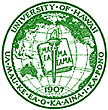
Dobelle dumps both
new proposed logos"We are going back to the drawing
board," he tells an alumni group
More than 100 alumni applauded University of Hawaii President Evan Dobelle's announcement yesterday that he was withdrawing two proposed new UH logos.
"This does not meet my common-sense test. ... We are going back to the drawing board," he told the Alumni Association's Lifetime Member Luncheon at the Waialae Country Club.
Last week, the university unveiled the two proposed logos -- called "Spectrum" and "Wave" -- and planned to pick one later this month. But a flood of criticism soon followed with many complaints focusing on the $82,000 price tag, the out-of-state logo designer and the appropriateness of the designs.
"It was a bad decision," said 1972 UH alumna Susan May of the proposed logos. "(Dobelle) corrected it."
Do you like
these logos?
Dobelle said he will seek advice from the Board of Regents at its May 15-16 meeting.
Robert Rytter & Associates, of Baltimore, was awarded the $82,000 contract to design a logo to represent the university's 10-campus system. At a press conference, Dobelle said the administration will continue to work with the firm to come up with an acceptable design. "They want to do the job right," he said.
But he said he is considering the possibility that others could submit logo designs. He also said he would like to see a rainbow incorporated into the new logo because it "is part of the culture of Hawaii."
"These are not acceptable. We need something that will work around the world," he said. "The logos that they have are a little jarring."
An online petition against the two logos garnered more than 1,760 "signatures" by 5:30 p.m. yesterday.
UH spokeswoman Kate Wester said the university received more than 1,200 e-mails about the logos: 40 percent were positive while 60 percent were negative.
Wester said a majority of those who liked the logos favored the "spectrum" design.
Paul Kalaiwa'a, a 1987 UH alumnus who attended the luncheon, said the university should consider using its seal as its logo. It incorporates the uniqueness of Hawaii, said Kalaiwaa, adding that the proposed logos "looked like a corporate seal."
Mike Dahilig, president of the Associated Students of the University of Hawaii, said Dobelle's decision was "a positive step toward recognizing that people of the university are not 100 percent behind this."
"The logos did not embody what the university represents, what the people are about. ... A logo is supposed to stand out to you and say 'wow.' Instead, I was scratching my head not knowing what to think of it," said Dahilig.
"You try to figure out what the heck it is. Is it a ninja star?" he said of the spectrum logo.
Dahilig said he hopes the university will include more students, faculty and community members in the logo process. "There needs to be more of a collaborative effort than a consultation effort."
Some faculty members were glad to hear that Dobelle decided to pull the logos.
"I don't think either design was appropriate. I think the president made the right move," said John Wisnosky, art professor and chairman of the university's art department.
"I have a letter to the Board of Regents that said if we're going to have a logo type, it should show the dignity, the stature, the tradition and the nobility of an institution of education. It should also show the potential of the institution," Wisnosky said.
Tom Klobe, art professor and director of the University of Hawaii art gallery, said, "It was great news."
The logo designs did not tie into the traditions and meaning of the university, Klobe said. "That could have been for any resort in the state. It spoke nothing that communicated education here," he added.
Some regents also have raised concerns about the logo, said Paul Costello, vice president of external affairs.
Despite the negative feedback the university received on the proposed logos, Costello said he appreciated the response from the community. "People here care deeply," he said. "It's important we do it right."
The Associated Press contributed to this report.
University of Hawaii

